Glass as an element of interior decoration? This boring, unattractive, unremarkable, except transparency, surface? Why not? Naturally, not in its original form, but after some refinement, but it is quite capable of becoming a magnificent decoration of a stylish composition.
What is needed for that? Just make a drawing on the glass. And here it is not necessary to have the talent of an artist. The question of its design can be solved in a variety of ways. Here’s how to do the painting on the glass with your own hands and we’ll get acquainted below.
What can be the painting of glass?
Decorate the glass surface in several ways:
1. Draw according to your fantasies.
2. Associate with stained glass.
3. Decorate using stencils.
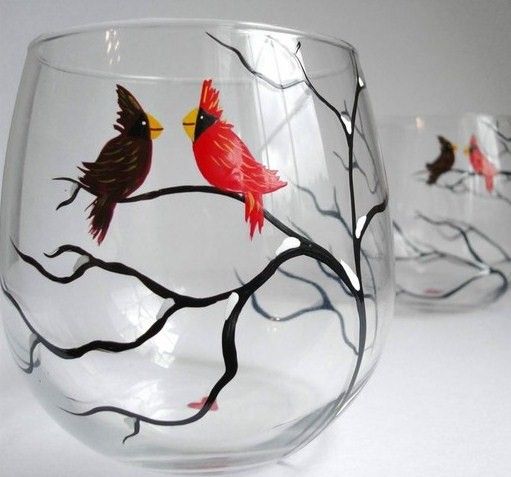
Glass surface decoration
Stained Glass Painting on Glass
Stained glass – the spectacle is impressive, but, unfortunately, today is extremely rare in interiors. The reason for this is its high cost and specificity of the decor. True stained glass will be an ornament of not every situation. Coming to us from the palace and church designs element, managed to maintain its fidelity to classicism. In order not to give a unique design decision to become a complete rarity, the designers took on the colors and simulated the technology by developing stained glass on the glass.
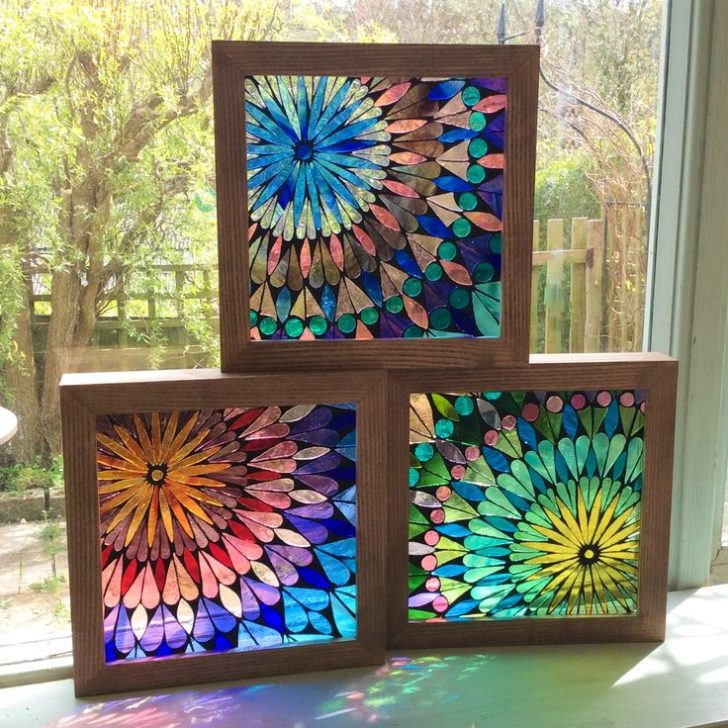
Stained Glass Painting on Glass
Now a stained glass is often called a canvas, not assembled from a multicolored glass mosaic, but a window glass that is usual, painted with stained glass. The latter is much cheaper in production, although visually virtually indistinguishable from the real stained glass. It is used in the design of premises in the Mediterranean style, modern, provence.
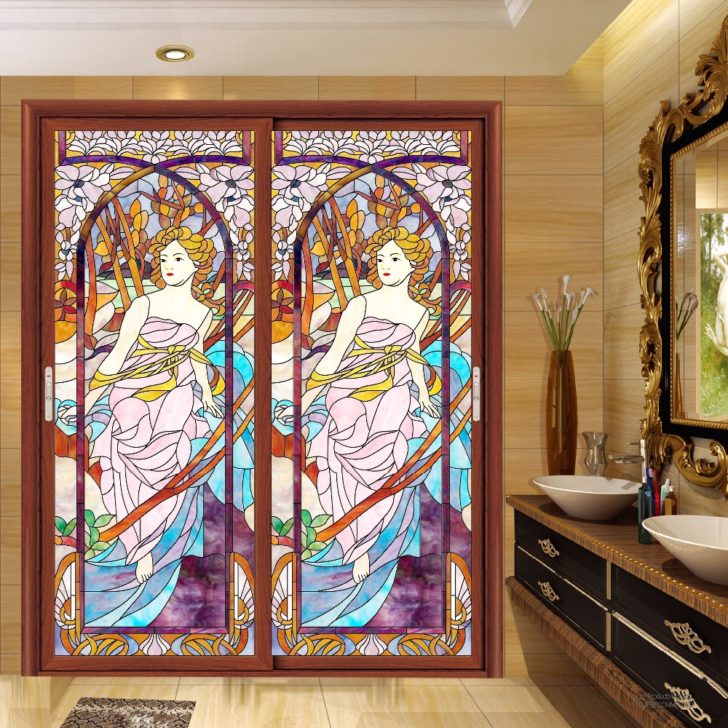
Visually, painting is almost the same as real stained glass
Stencil drawing on glass
This technique will greatly help those who can not paint beautifully. Stencils for painting on glass will help decorate the surface evenly and neatly. Interesting stamping patterns are offered in shops specializing in goods for creativity and decoration. It is possible to make unpretentious preparations yourself. Ideas of pictures for painting on glass can be searched on the Internet.
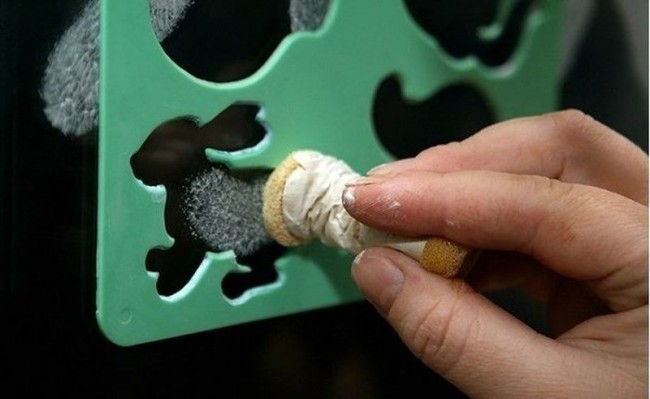
Stencil for painting on glass
Stencils are:
- single use;
- reusable.
The first are made of paper or cardboard, the latter – from self-adhesive polymer film. How to use stencils for painting on glass will be considered below.
Arbitrary drawings on the glass
“Drawing on glass can be applied for a long time or for a short period”
Painting on the glass with your own hands is an excellent opportunity to make the interior unique. You can paint the glass surface as you please, the main thing is that the picture and the color solution correspond to the overall interior mood of the room.
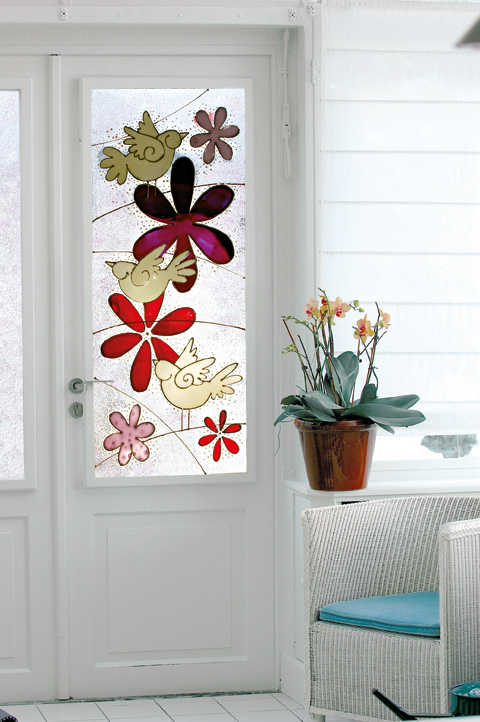
Drawing on the glass will make the interior unique
The pattern on the glass can be applied for a long time or for a short period. In the latter case, they are painted with easily removable paints and do not resort to protective fixation of the image. So often come on the eve of any celebrations. For example, to paint windows and door glass is accepted on the eve of New Year’s holidays. Beautiful pictures chosen for painting on glass, will help create an appropriate atmosphere in the room.
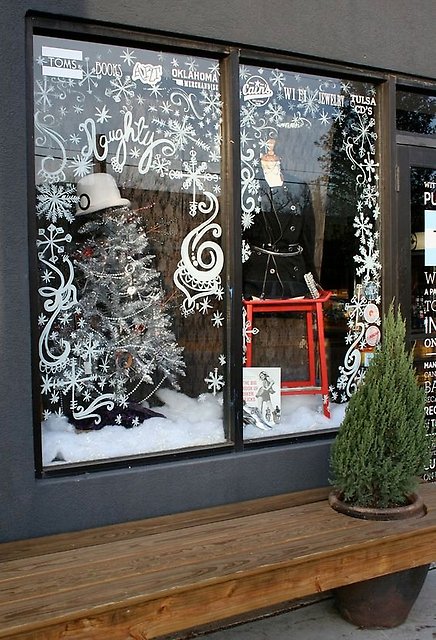
Temporary New Year’s painting on glass
What is being painted on glass and ceramics?
“The most relevant and designed for a long lifespan are nitro-oil paints that perfectly fit, perfectly adhere to the pattern on the glass and have practically no drawbacks”
There are factory and home-made paints for glass painting. Self-made compounds are known 4. The most simple and unstable is prepared from aniline and PVA. Aniline can be mixed with gelatin. The effect will not be much better, as the stained-glass paint will quickly burn out in direct sun, but if you need to get the ideal quality of the meniscus – it is not equal to it.
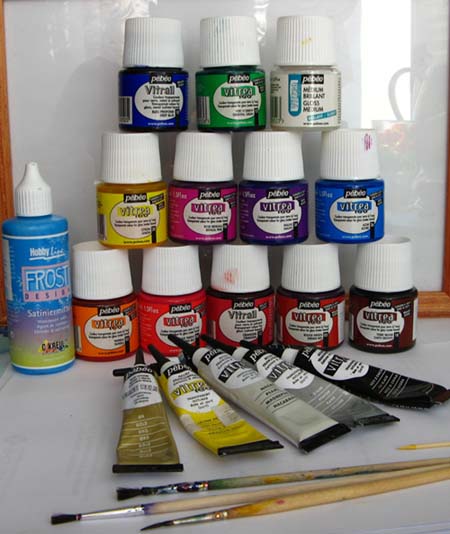
Paint for painting on glass
The legacy of Soviet-rare recipe includes glue BF-2 and paste from ballpoint pens. Nitro-oil paints that perfectly fit, perfectly sticking in the picture on the glass and practically without defects are considered to be the most actual and long-lasting ones.
We prepare PVA-aniline
To prepare PVA-aniline paint for painting on glass and ceramics, you will need to prepare the ingredients: dilute twice with distilled water 100 ml of glue base and dissolve, according to the instructions, powder aniline dye. The resulting color solution is filtered through a thin nylon. Now it’s time to play with shades. Aniline in the glutinous emulsion is added with drops. The saturation of the color is checked on the glass. In nedononirovannoy stained glass paint will have to add a pigment, in a sated – glutinous emulsion.
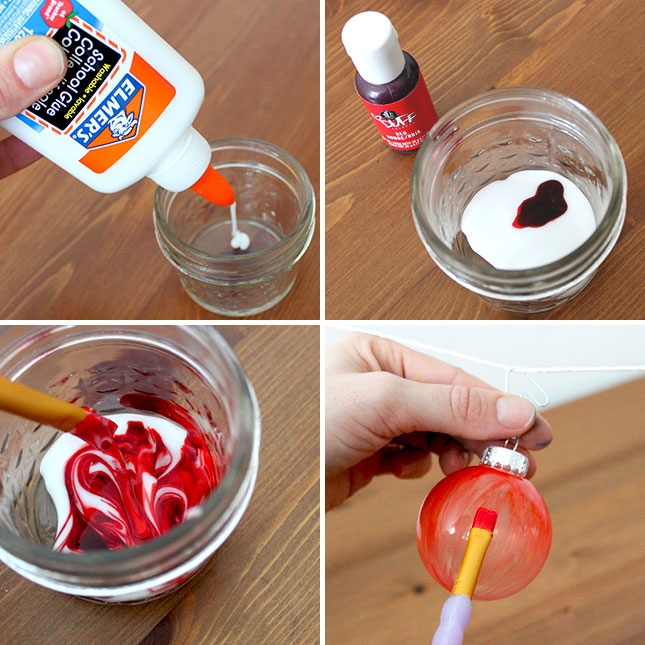
Paints on glass can be made by own hands
We prepare the gelatin-aniline mixture
200 ml of distillate is heated to 50 ° C, after which 6 g of ordinary gelatin is diluted in it. The aniline mixture is prepared according to the above procedure. The dye is also added to the cooled gelatin by drops under regular control of the level of saturation of the paint. In stained glass on glass, made with such a composition, wear resistance can be increased.

Gelatin-aniline paint has increased wear resistance
After drying, the pattern on the glass is enough to cover with a colorless acrylic lacquer. Do not try to repeat this with PVA-aniline stained glass paints. They are not designed for such delights and will simply float.
Preparing the Soviet recipe
The required amount of BF-2 is dissolved in a double volume of acetone. The core paste is added to the resulting solution. The mixture must be thoroughly mixed. Whether the desired shade is obtained, also checked by glass.
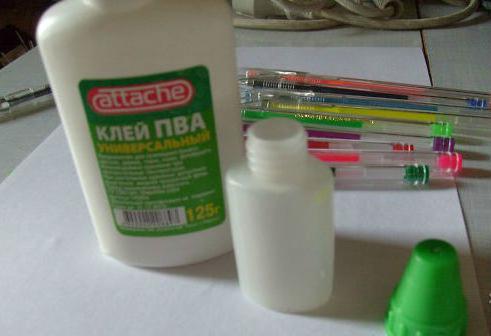
Paint with core paste
We prepare the nitro-oily composition
The proportionality of this mixture is 60×40, where 60% of the volume will be taken by a transparent furniture nitrolac, while 40% will remain for 647 solvents. It is necessary to give color to the composition with artistic oil paints. Since it is a paste-like composition, it dosages it, being guided by the size of a pea. After thoroughly kneading, the combination is checked for shade matching.
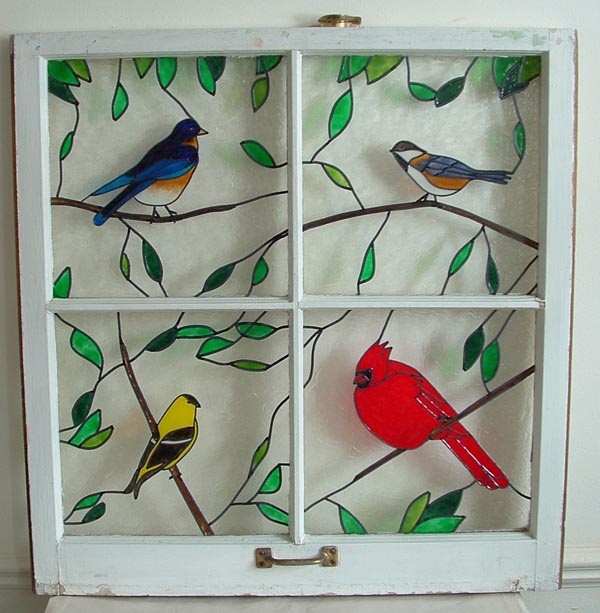
Nitro-oil composition can be varnished
Painting on glass with stained-glass paints of this type can also be covered with a layer of varnish. This will make the product even more aesthetic.
Finished paints on glass can be:
- universal;
- water based;
- glossy;
- acrylic;
- stained glass.
Universal
These are paints on glass and ceramics. They also can paint faience and polystyrene, plexiglas and all kinds of plastic. The compositions are perfectly arranged. Drawings on glass for a long time retain the contrast of shades and are not washed off with water. Not suitable for painting food utensils.

Universal paints are not washed off with water
Water based
Most often, such paints are needed to paint the glass, which is in a moist microclimate. To fix them on the surface, firing is required. After this treatment, the ink on the glass is not afraid even of repeated mechanical washing in the dishwasher. In addition to all, they are completely non-toxic, so they are allowed in the list of utensils used in everyday life.
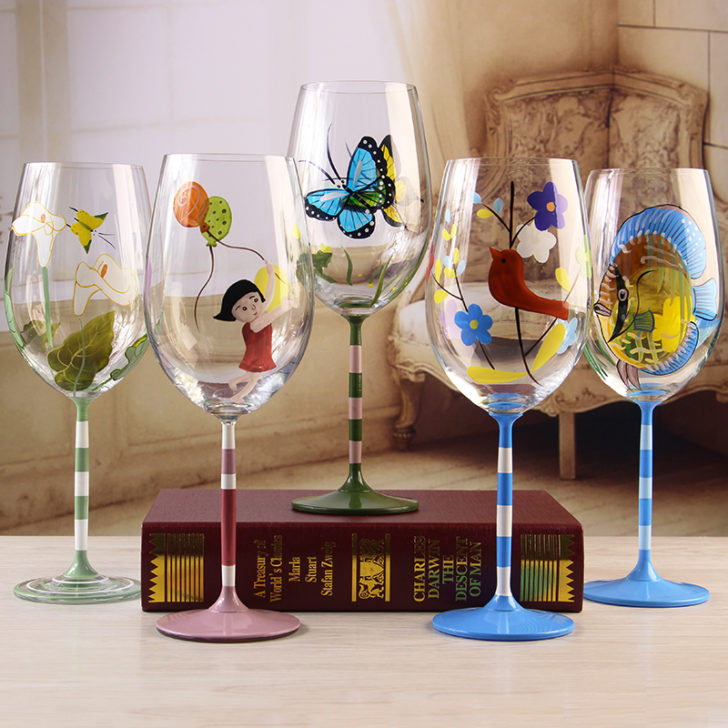
Paints on a water basis suitable for painting utensils
Glossy
Paints can be mixed together. Painted by them pictures differ brightness, depth of shades, pleasant shine. Apply in two layers. Each person needs at least two days to dry. Glass painting will need lacquer protection.

Glossy colors are distinguished by brightness
Acrylic
Quick-drying with good adhesion paint, used both for creating conventional drawings, and in stained glass paintings. Extremely stable. Do not fade and do not fade. The drawings they made are matte. Belong to the category of universal, as the paints can be painted, both in glass and in ceramics.

Acrylic paints do not fade and do not fade
Stained Glass
This type of paints are divided into fired and non-combustible.
Burnt
After application, the pattern on the glass should be fired in the oven. This is not always acceptable for large panels, for example. What to do in this case? Just leave the picture to dry yourself, removing it into a secluded corner. In a week you will receive a full-fledged product. How will this look on the glass look, look at the photo. Here the main thing is not to let the outlines of the picture blur, and do not lubricate the lines, because the unfired paints will be long vulnerable.
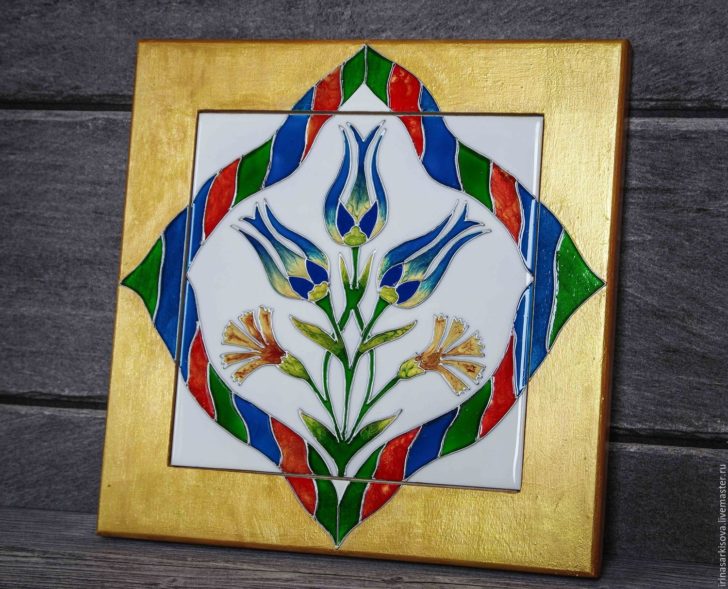
Stained-glass paints with roasting
Non-combustible
These stained-glass paints differ in brightness, but in the technique of application are more complex. Selected pictures for painting on glass are drawn in stages. First, the outline of the future masterpiece is drawn, and then free spaces are filled. It is also a long-lasting, for drying, kind of stained-glass paint, and each variation will have individual terms for it. Painting on glass and ceramics is protected by a layer of varnish. Persistence of paints varies, but no matter how it is a picture, it will not be possible to soak and even more so to subject to mechanical cleaning.
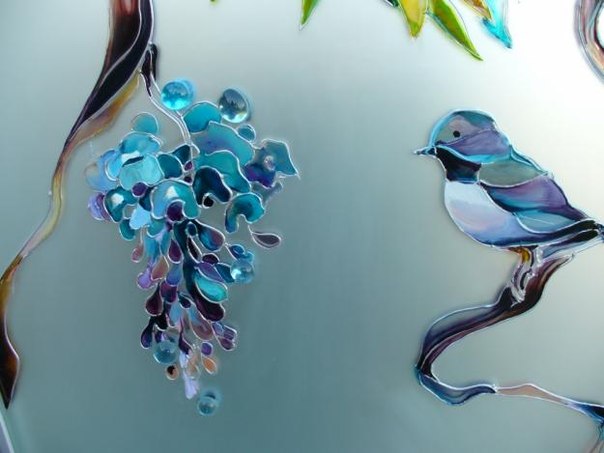
Drawing on the glass with stained-glass paints
If you look at the examples of painting on the glass in the photo, you can see that in addition to the color spots there are many fine lines on them. To make them in the glass, use markers and contours.
Markers
They help in the drawing of fine lines. Water base allows them not to spread on glossy surfaces. After drawing the picture on the glass, the product is sent for firing.
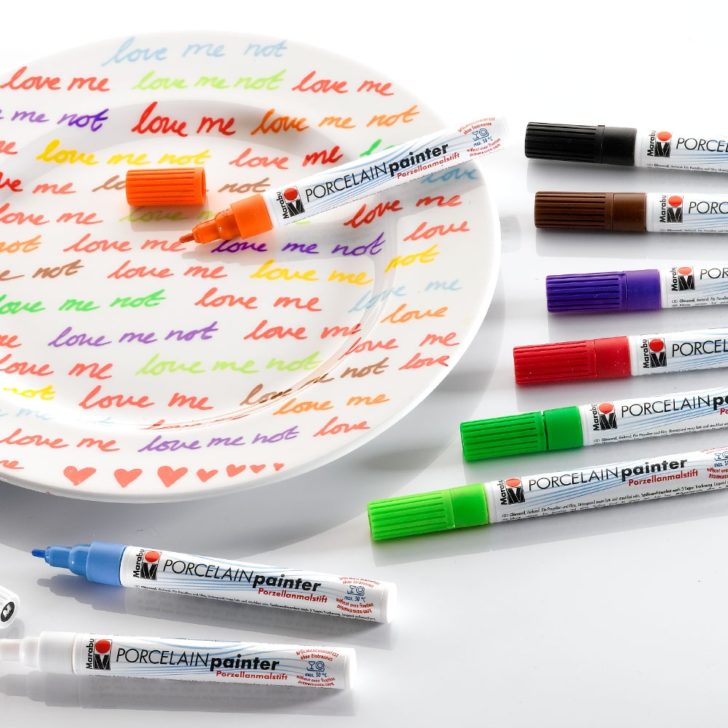
Markers for glass
Contours
Contours-reliefs have the form of applicators with a narrow tip, which is very convenient for applying thin even lines.

The contours are very convenient for applying fine lines
What can paint paint on the glass?
The figure on the glass is relevant everywhere, where there is a suitable area for its application to the surface. A perfect addition to the painted glass door insert will be a similarly designed lampshade of the wall sconce, floor lamp or ceiling lamp. You can decorate the interior with stained glass paintings. Looks good on glass in niches, on partitions. Stained glass inserts are often decorated with ceilings.
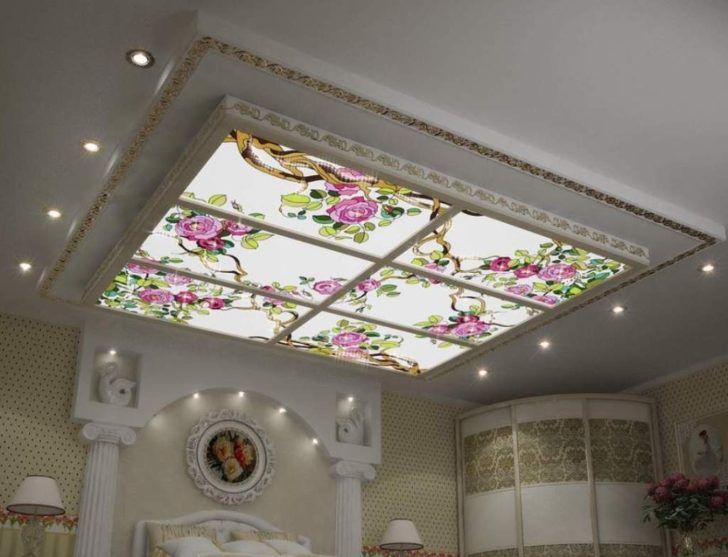
Ceiling decoration with stained glass inserts
The glass painted for stained glass can become an element of the stairs decor in two-level apartments, it is inserted between wooden or stainless steel balusters. The painting on the glass with stained-glass paints will decorate the kitchen set, the shower cabin, the doors of the wardrobe.
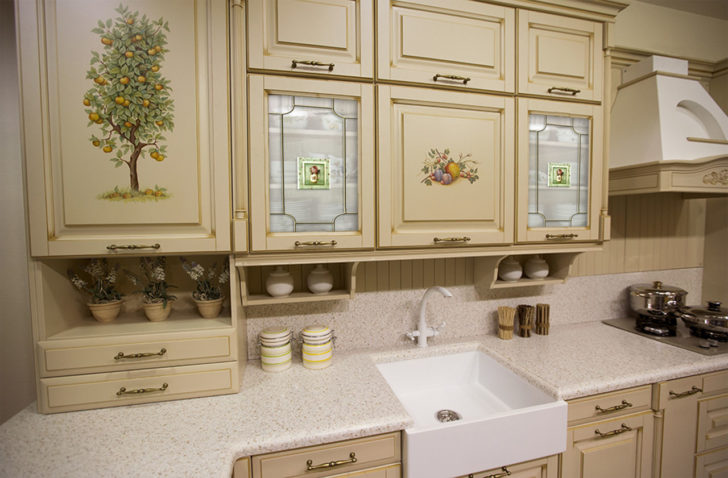
Drawing on the glass in the interior of the kitchen
Painting on glass by own hands
Let’s begin our consideration of the question by using stencils in the glass painting. The simplest models, many are quite able to do at home. To do this, do not even need to draw something: just find a suitable picture for painting on the glass in a photo on the Internet and print it. Exactly cut out the details will help the stationery knife. If you want to paint the windows of several windows or doors, then it is better, of course, to buy a reusable template.
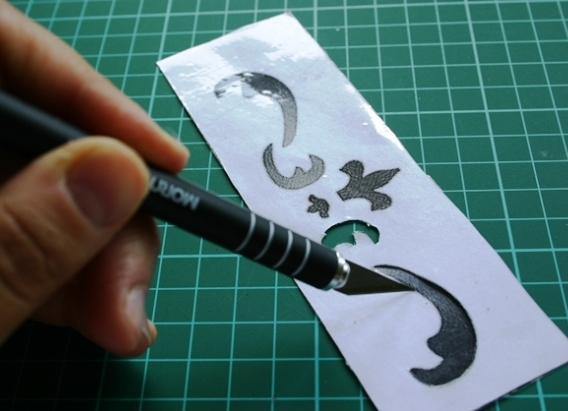
Cut out stencil details will help a stationery knife
How to use the stencil
To paint the glass in this technique will require stained glass or acrylic. Depending on the type of pattern being reproduced, you can use a brush or a sponge. Choosing a picture for painting on glass – it’s purely personal. What you need to work:
- glassware itself;
- degreasing liquid;
- paint on glass;
- brushes;
- Scotch;
- stencil.
Stage I. Degrease the surface. Do it necessarily. The glass should be free from stains and dirt, so that it can be evenly applied to the paint. Prepare the surface can be treated with a cotton swab moistened with alcohol.

Degreasing the surface
Stage II. Apply the stencil to the glass and, if necessary, fix it with an adhesive tape. Fixation will make it fixed, which eliminates errors in the work.
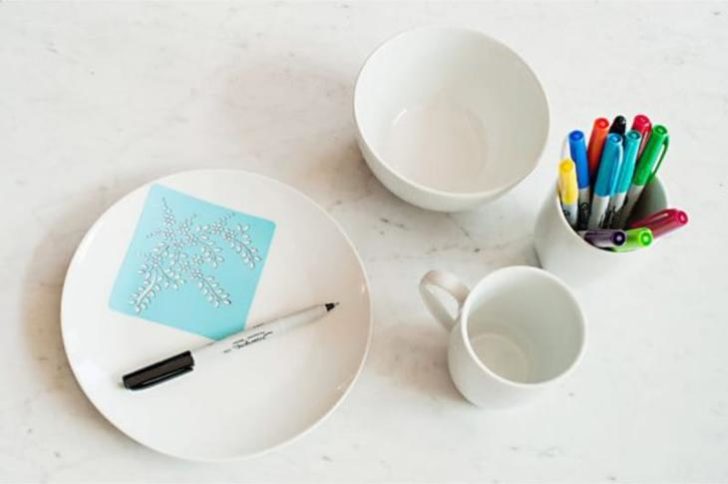
Stencil Fixation
Stage III. We proceed to painting on glass with stained-glass paints. Foam or a swab of cotton wool is dipped in the paint and blotting it out through the stencil voids.
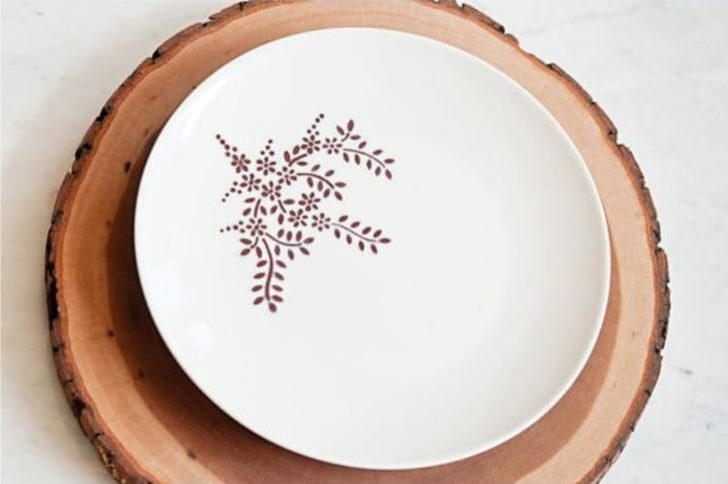
Ready-made painting
Point technique of painting
To work will need contoured paint. Ideally, not a full-color, but a contour drawing on the glass is reproduced. On the outline lines, points of identical size are placed and at a uniform distance from each other. First, large elements of the selected image are drawn, and then small details. The size of the point is controlled by the force of pressing the tube.

Bit pattern on the glass
Contouring Technology
A method that allows you to get the most expressive and colorful drawings on the glass. For detailed drawing use thin brushes or contour paints.

Contouring technique of painting
After the workpiece has dried it will be possible to proceed with the coloring of the inside contour spaces. Work will require accuracy. Paints should not spread and go beyond the already outlined boundaries. How to properly perform this stage of painting on the glass will demonstrate the photo.
Technique of stained glass painting
Work that requires a certain skill. Stained-glass paints of liquid and slopes to spreading. In order to succeed, we must first note the contours of abstraction, covering the surface of the glass with a network of golden, black or silver lines. Draw them carefully, avoiding omissions and interrupting lines. Remember that the contours in the future will play the role of barriers that do not allow the flowing of color paints.
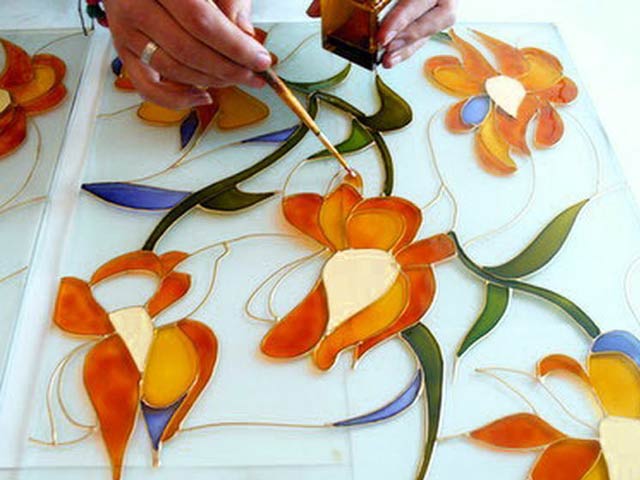
Stained Glass Painting on Glass
The blank for the stained glass on the glass should dry thoroughly, and only after that it can be recycled. When the picture is ready completely and dried, the panel is opened with a varnish.
Stained-glass window
The pattern on the glass, obtained by this method of application, is practically indistinguishable from the true stained glass. But this will only happen if the skillful hands are also attached to understanding the subtleties of lighting the picture. This will require specific refraction of the rays, which can provide a reflective substrate. This explains why the technique is often used for the design of mirror surfaces.
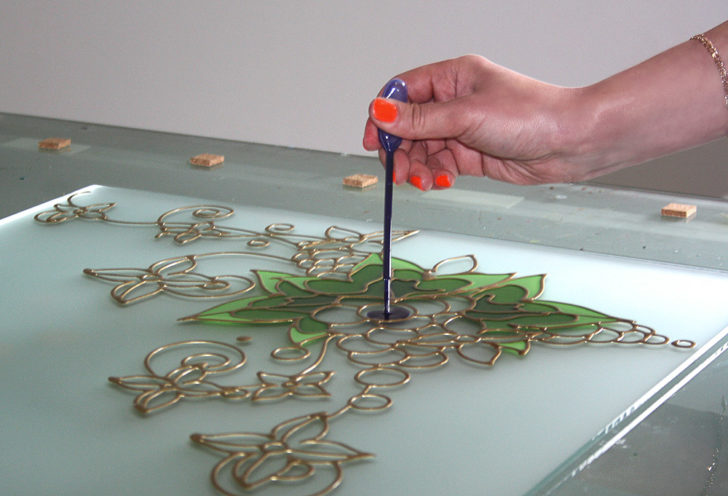
Stained-glass window with paints
With a high-quality cast, the stained-glass paint forms a meniscus. Different curvatures of refraction rays passing through it, make it play stained glass with color overflows. Since diffraction also affects the borders of the curb, the latter makes sense to make it dark and shiny. How it will look like painting on the glass at this stage, look at the photo.
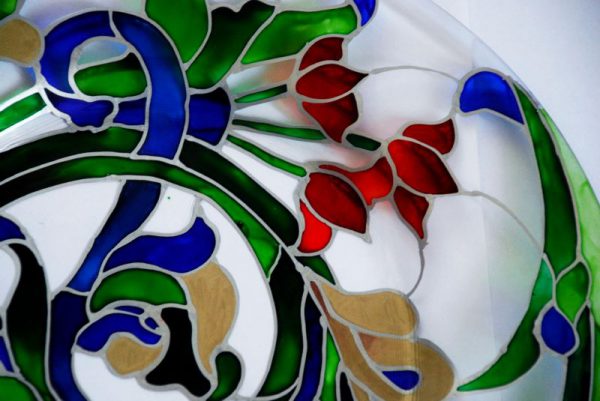
Stained glass painting on glass
The filling window is made using the following algorithm. First of all, the assembly table is being prepared. Its surface is covered with a white bike, bryu, flannel. The fabric of the pattern is laid on the fabric, which is covered with pre-skimmed glass. Now you need to fix the workpiece along the contour. This is done by the utensil PVA. The glass stays dry for a day. After that, the most difficult part of the procedure for painting glass with stained-glass paints will begin – filling the formed cells. They are filled in turn. Allowing each of the batches to dry.

Paint the cells with paint
If a leak occurs, it can be removed gently by removing the razor blade. Bay the last cell of the stained glass should be left for another day to dry. Then the resulting pattern on the glass can be inserted into the frame or metal frame, if it was preparing the panel and send it to the place allocated to it.
On the technique of filling with painting on glass with stained-glass paints it is worthwhile to dwell in more detail. The cells are painted over with a richly wetted brush or filled with a syringe, distributing it along the contour. In this case, the curb is strictly prohibited. The paint should flow into the meniscus on its own, naturally. If its concentration is liquid, then after drying the cell bay is repeated. Do not pour or top up the paint in the center of it. If the painting on the glass is done by oneself and the process needs to be adjusted, then for the thickening of the color spot, experts recommend that the two beams be framed at once by the inner and outer contours. Provided that in the center of the cell a “bloom” is formed, then the light refraction will be violated and the stained glass painting will lose its meaning. If there are a lot of such piercings, then the picture on the glass will become untidy and you will not see the conceived effect.
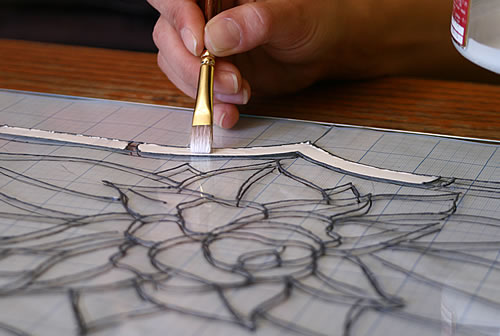
Fill the path with a brush
Marmoring
Another interesting and quick way to paint glass. Special, different shades of paint on the glass alternately a thin trickle pour into the center of the container, filled with warm water. The formed colored circles are stretched into the drawing with a toothpick. The decorated object is dipped in the prepared font.

Marmoring of glass
After extraction, an abstraction pattern will remain on its surface. The picture will very much resemble the structure of marble. The paint is allowed to dry and the pattern on the glass is lacquered. Thus it is possible to make out glasses, bottles, dishes, small plafonds, mini-panels.

Decorating the legs of a glass of marbling
Conclusion
Painting on the glass with your own hands is a fascinating activity! Techniques are not complicated and are available for everyone to learn. Decorating drawings can be any glass, whether it’s a large thing or a small bauble. It does not matter at all whether you will draw a plate or a window glass, the main thing is to get into the topic and mentally!
Photogallery – drawing on glass
Video
Author: Mikhail Bond

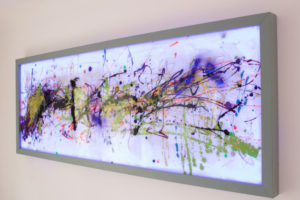
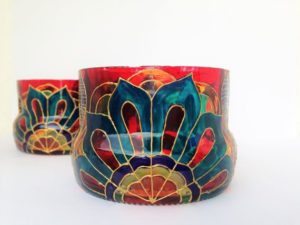


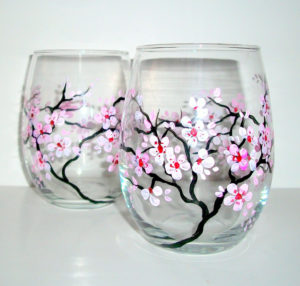

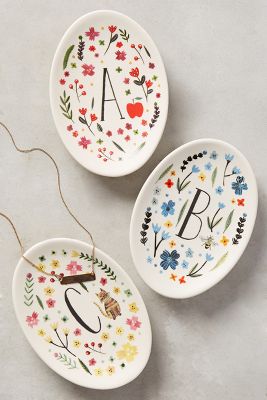
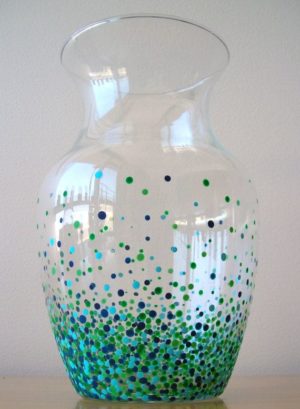

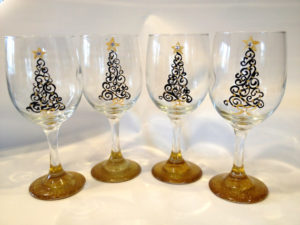
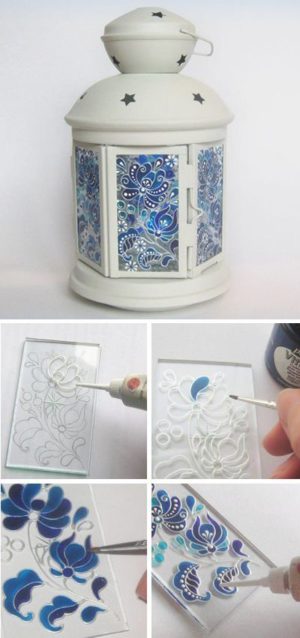
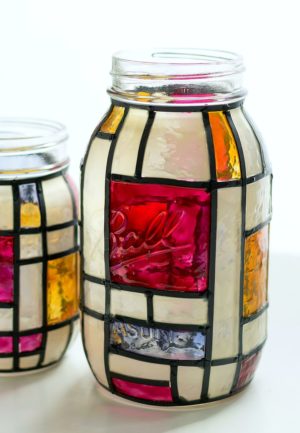


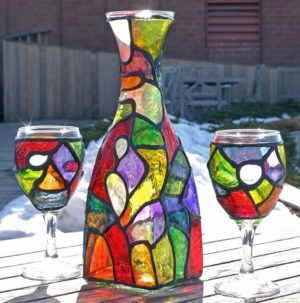
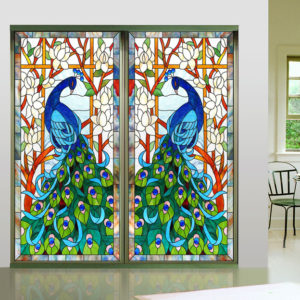
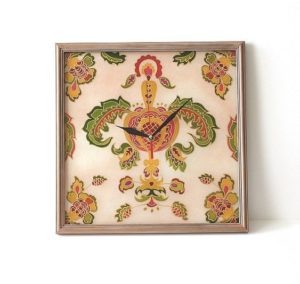
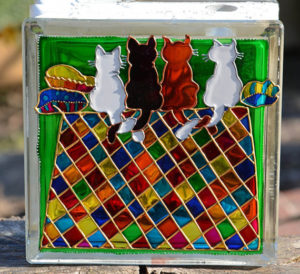
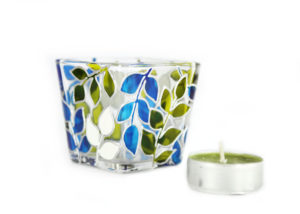
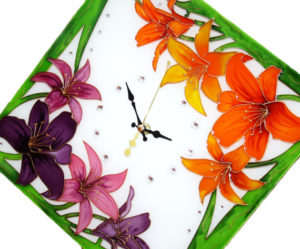
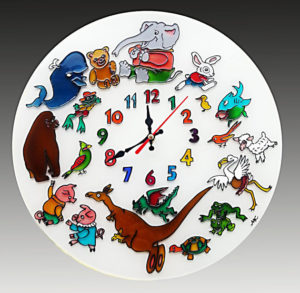
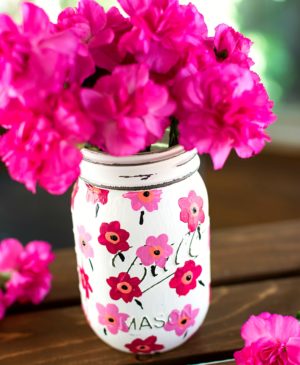

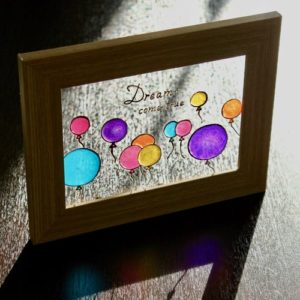
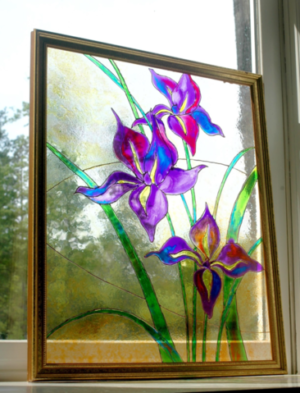
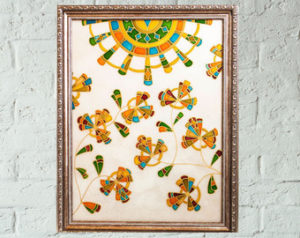
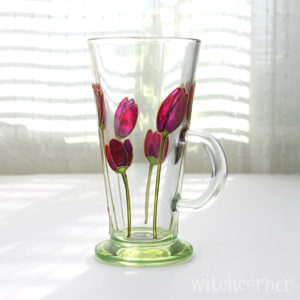

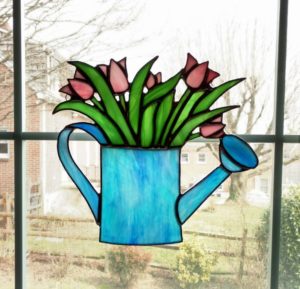
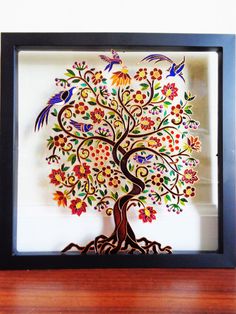
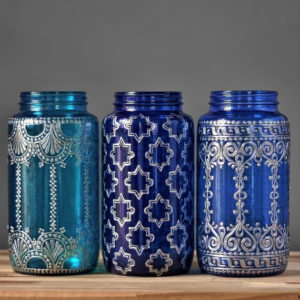
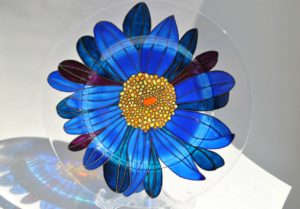
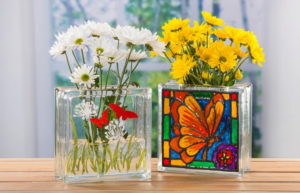
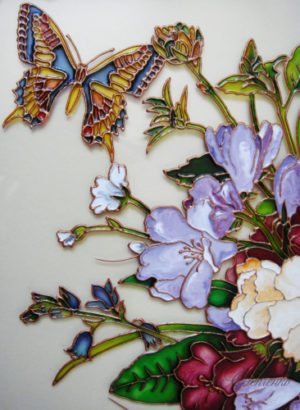
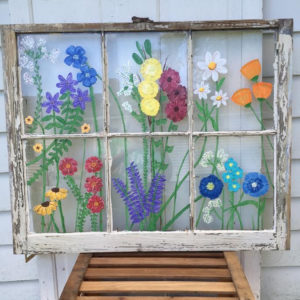
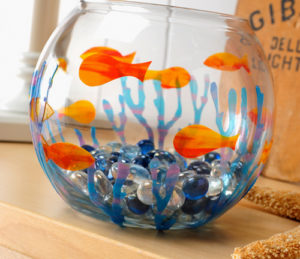
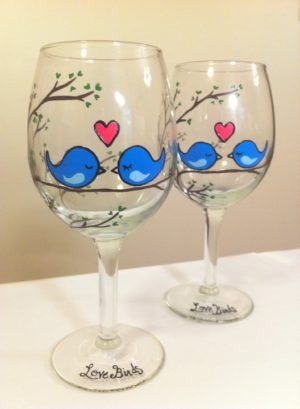
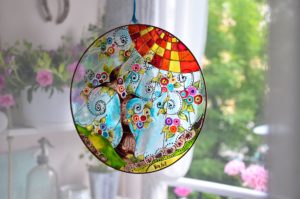
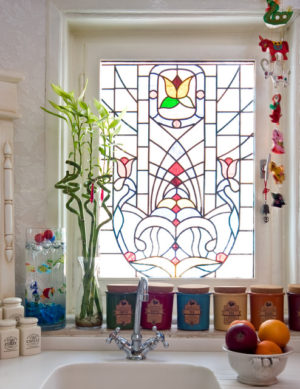


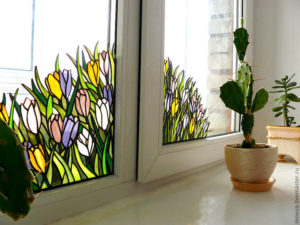

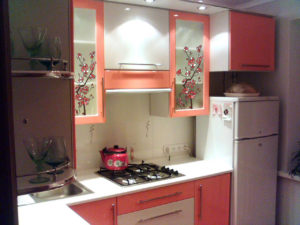
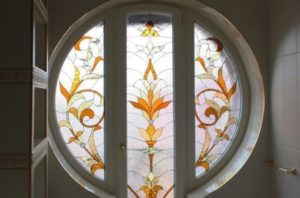
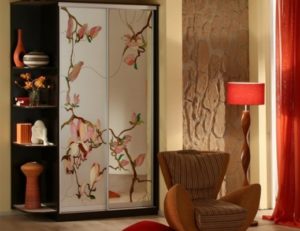
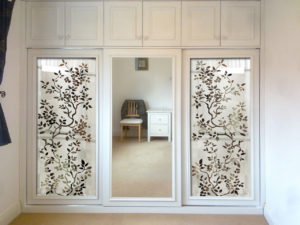
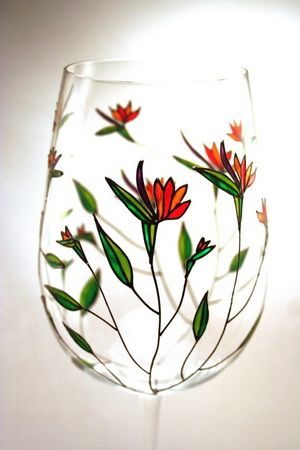
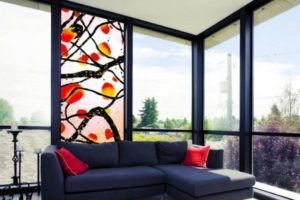
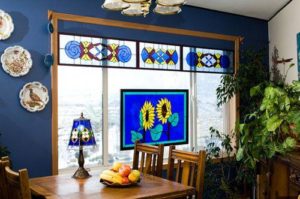
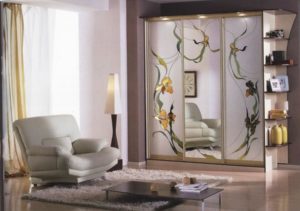
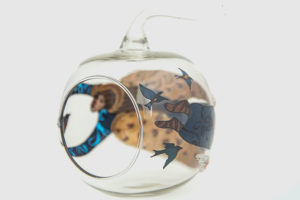

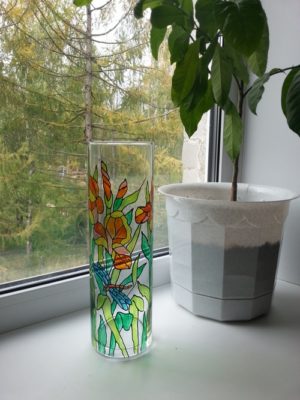
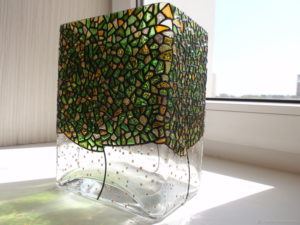

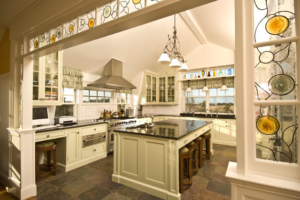
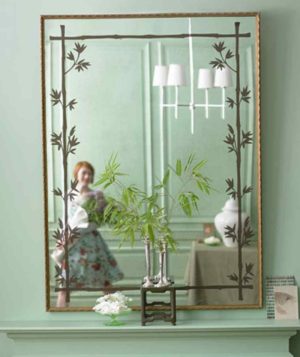
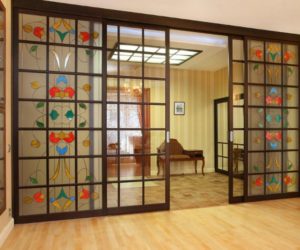
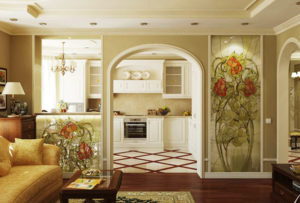
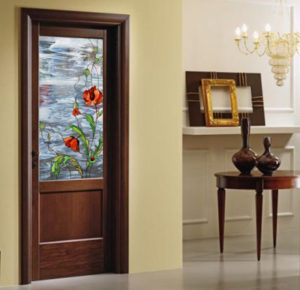
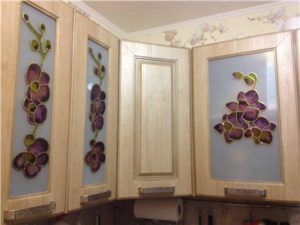
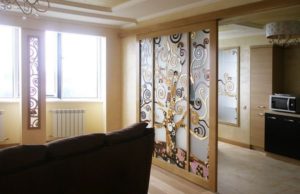

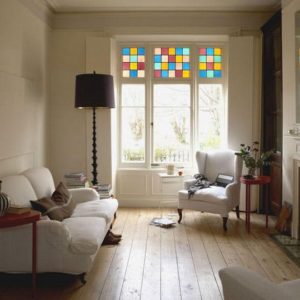
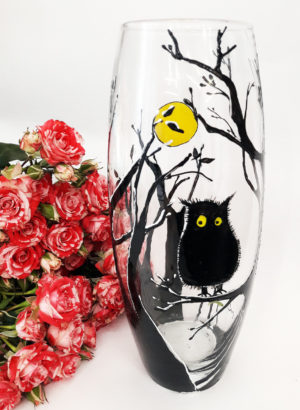
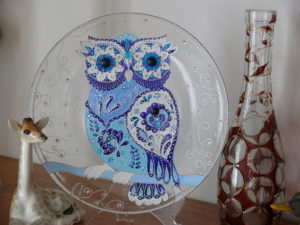
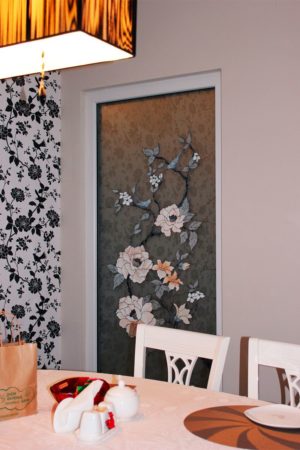
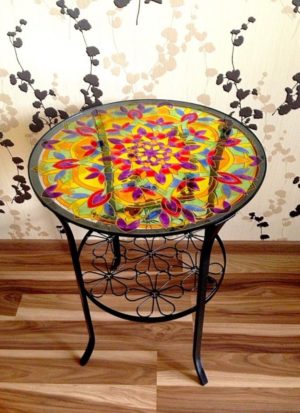
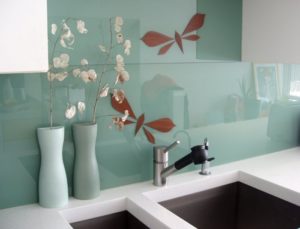

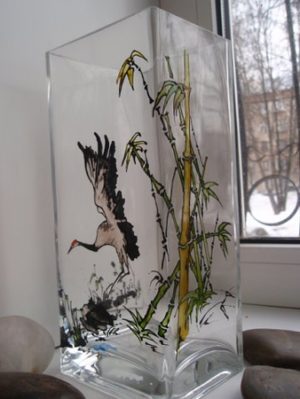
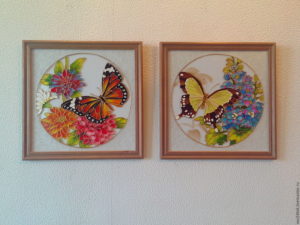

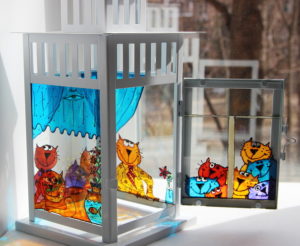
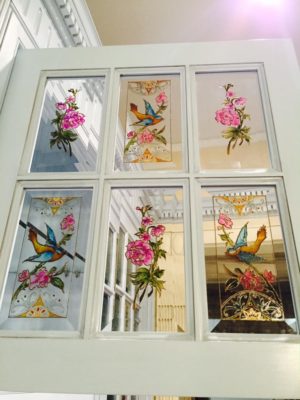

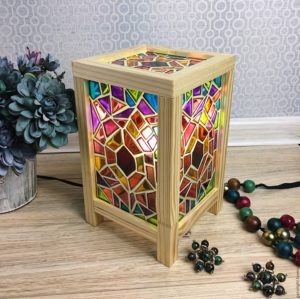
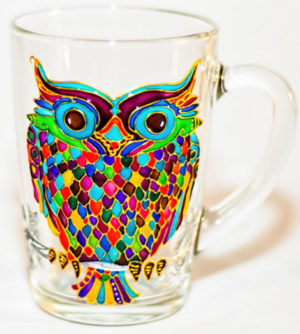
05.05.2023 @ 19:51
g on glass and ceramics should be chosen carefully, taking into account the durability and quality of the final result. The most relevant and designed for a long lifespan are nitro-oil paints that perfectly fit, perfectly adhere to the pattern on the glass and have practically no drawbacks. In addition, acrylic paints are also suitable for painting on glass, but they are less durable and may fade over time. When choosing paints, it is important to pay attention to their compatibility with the surface of the glass or ceramics, as well as their resistance to moisture and temperature changes. With the right choice of materials and techniques, glass and ceramics can become a beautiful and unique element of interior decoration.